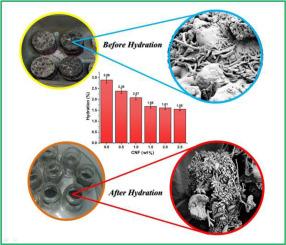Investigation of hydration, corrosion, and thermal shock resistance of MgO–CaO Ceramic Composites reinforced with electrospun carbon nanofibers
IF 5.7
3区 材料科学
Q2 MATERIALS SCIENCE, MULTIDISCIPLINARY
引用次数: 0
Abstract
MgO–CaO ceramics, known for their strength, thermal stability, and affordability, are widely investigated, but their susceptibility to hydration can compromise their structural integrity and performance. In this study, up to 2.5 wt% of electrospun carbon nanofibers (CNFs) were added to the MgO–CaO matrix. The MgO–CaO![]() CNF composites were first compressed at 100 MPa, and then sintered for 3 h at 1400 °C in an N2 environment. The hydration resistance, corrosion resistance, and thermal shock resistance of the composites were assessed. Then, the structure, microstructure, and phase composition of samples were examined using XRD, FESEM, and EDS. It was revealed that the addition of CNF improved the hydration resistance by covering the surfaces of the CaO and MgO particles, preventing water absorption at the grain boundaries, and filling the pores. Furthermore, the results indicate that using CNFs considerably improves the corrosion resistance and thermal shock resistance of MgO
CNF composites were first compressed at 100 MPa, and then sintered for 3 h at 1400 °C in an N2 environment. The hydration resistance, corrosion resistance, and thermal shock resistance of the composites were assessed. Then, the structure, microstructure, and phase composition of samples were examined using XRD, FESEM, and EDS. It was revealed that the addition of CNF improved the hydration resistance by covering the surfaces of the CaO and MgO particles, preventing water absorption at the grain boundaries, and filling the pores. Furthermore, the results indicate that using CNFs considerably improves the corrosion resistance and thermal shock resistance of MgO![]() CaO composites.
CaO composites.

电纺碳纳米纤维增强氧化镁- cao陶瓷复合材料的水化、腐蚀和抗热震性能研究
MgO-CaO陶瓷以其强度,热稳定性和可负担性而闻名,被广泛研究,但其对水化的敏感性会损害其结构完整性和性能。在这项研究中,高达2.5 wt%的电纺碳纳米纤维(CNFs)被添加到MgO-CaO基体中。将MgO-CaOCNF复合材料在100 MPa的压力下压缩,然后在1400℃的N2环境下烧结3 h。对复合材料的抗水化性能、抗腐蚀性能和抗热震性能进行了评价。利用XRD、FESEM、EDS等分析了样品的结构、微观结构和相组成。结果表明,CNF的加入通过覆盖CaO和MgO颗粒表面、阻止晶界吸水和填充孔隙来提高水化性能。此外,研究结果表明,CNFs的使用显著提高了MgOCaO复合材料的耐腐蚀性和抗热震性。
本文章由计算机程序翻译,如有差异,请以英文原文为准。
求助全文
约1分钟内获得全文
求助全文
来源期刊

Materials Research Bulletin
工程技术-材料科学:综合
CiteScore
9.80
自引率
5.60%
发文量
372
审稿时长
42 days
期刊介绍:
Materials Research Bulletin is an international journal reporting high-impact research on processing-structure-property relationships in functional materials and nanomaterials with interesting electronic, magnetic, optical, thermal, mechanical or catalytic properties. Papers purely on thermodynamics or theoretical calculations (e.g., density functional theory) do not fall within the scope of the journal unless they also demonstrate a clear link to physical properties. Topics covered include functional materials (e.g., dielectrics, pyroelectrics, piezoelectrics, ferroelectrics, relaxors, thermoelectrics, etc.); electrochemistry and solid-state ionics (e.g., photovoltaics, batteries, sensors, and fuel cells); nanomaterials, graphene, and nanocomposites; luminescence and photocatalysis; crystal-structure and defect-structure analysis; novel electronics; non-crystalline solids; flexible electronics; protein-material interactions; and polymeric ion-exchange membranes.
 求助内容:
求助内容: 应助结果提醒方式:
应助结果提醒方式:


